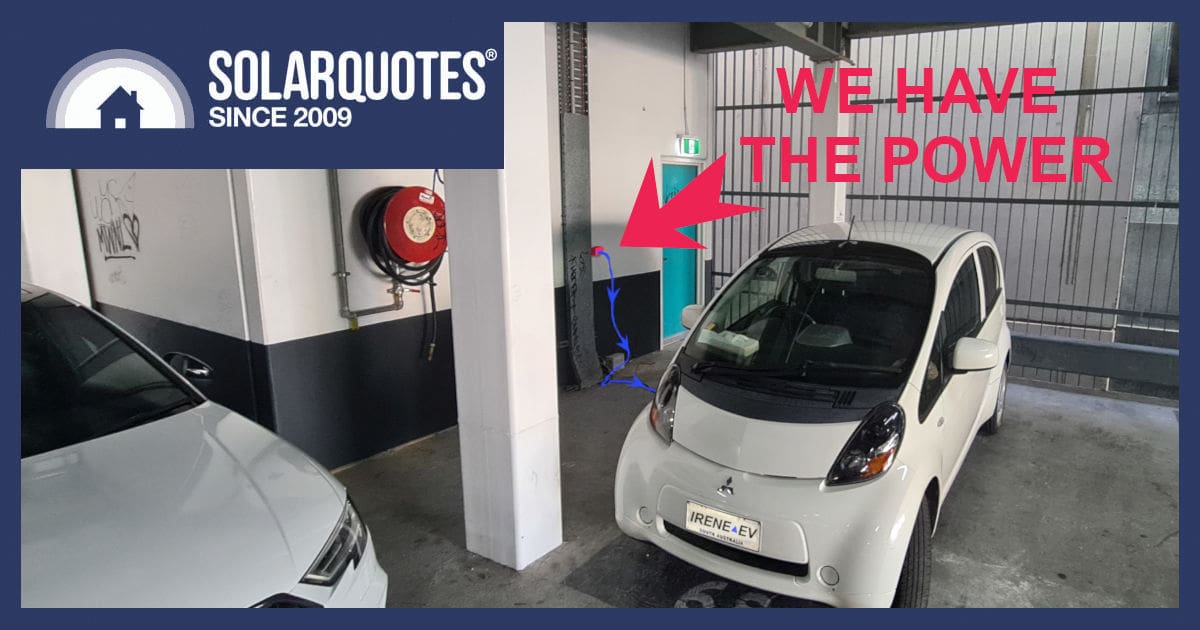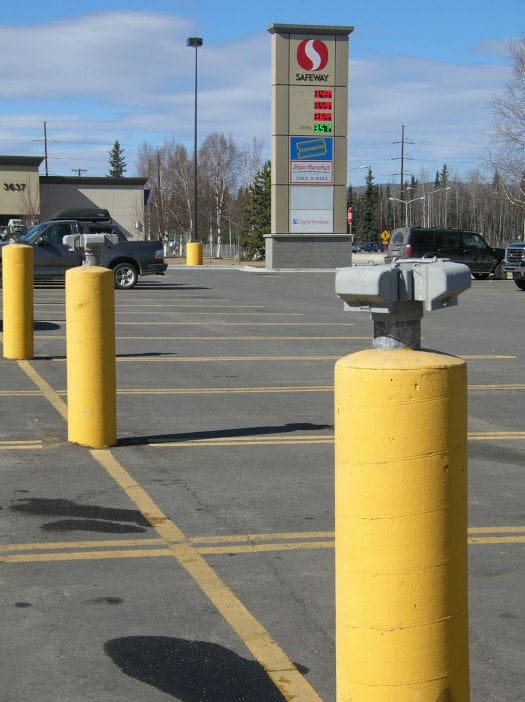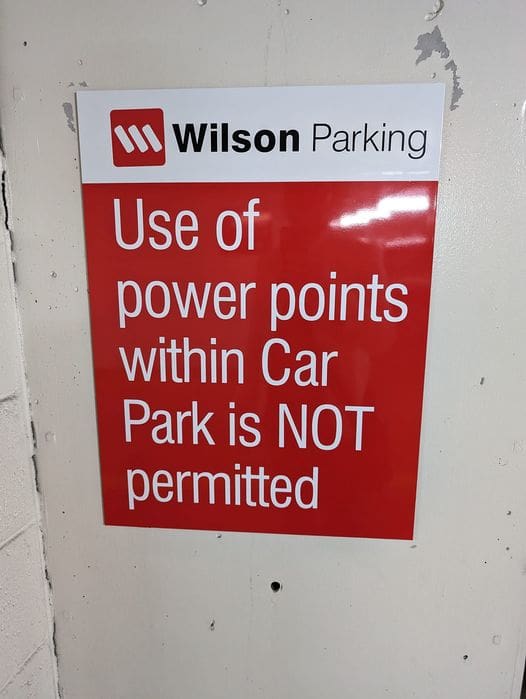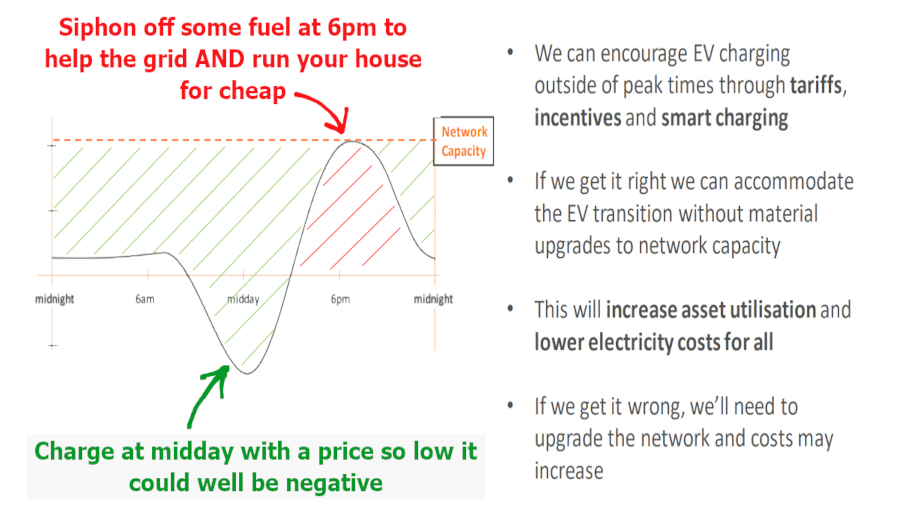
We need more EVs charging during the day. Not just fancy charging stations – plain power points in every car park will do the trick.
It will offer huge benefits, drawing cheap solar energy when its plentiful and freeing cars up to discharge back to the grid at night.
Why Is Charging EVs During The Day So Important?
I’m calling it Daycharging and it means electric vehicles can make the most of cheap solar energy. Whether it is taking the opportunity to charge while working from home or rolling out more charging points at workplaces, a shift to daytime charging offers huge benefits to the grid.
Daycharging means that not only are EVs soaking up energy that otherwise goes to waste – it also frees them up to export power back to the grid at night through Vehicle-To-Grid (V2G) technology, making a liability into an asset.

Overseas you find shops incentivise customers with free electricity, albeit for fossil fuelled reasons. We should do the same for train stations.
How Do We Shift Thinking Around Charging Electric Cars?
Petrol is cheap compared to bottled water, but if petrol was something that fell on the ground, ran down the gutter and disappeared into the drain, I’m damn sure people would devise ways to soak it up and get it into their car.
It wouldn’t matter if it was a slow drizzle, when your car is parked for 8+ hours during the day, it might as well be doing something useful.
And if it made the air cleaner, the streets quieter, and it cost 70% less than going to the petrol station, why wouldn’t we rally in the street to demand more charging points at workplaces to make it a reality?
Seems we have Stockholm syndrome from queuing at petrol stations if they offer 10% discounts.

These people should be pilloried. Failing that legislation needs to be passed to force them into providing a good for the public, seeing as the public already pays for the road that brings them their customers.
Banging On For Years
I’ve been making this point for a long time, including in a piece a couple of years ago:
“Encouraging daytime EV charging is like hitching a ride on a wave of cheap solar energy flooding the grid. It’s a smart move, and it means we’re making the most of the huge battery storage capacity sitting in our rapidly growing fleet of electric cars across Australia. It bolsters the stability of our power networks during minimum demand events and, as Vehicle To Home rolls out, is set to provide increasing support when our infrastructure is under strain due to the evening peak. Your employees can tootle home and siphon off some ‘fuel’ to cook tea, run the TV and keep the fridge cold.”
Which reminds me that we still haven’t prioritised EV charging at my own workplace. I must write a sternly worded email to the landlord, he should be told his electrician is hopeless.

SA Power Networks (SAPN) are already planning what the network needs.
EVs Are The Answer To Falling Feed-In Tariffs
I’d like to reframe EVs primarily as super storage: packed full of technology but more importantly, bursting with sunshine.
When disgruntled home solar owners are braying like donkeys about how little they’re paid for solar exported to the grid, they need to realise EVs are the daytime demand we all need, to make feed-in tariffs worth while and lower evening peak demand.
I’ve been banging on about using type 1 charging for EVs before. It’s easy to control 2kW with a simple switched circuit.
Write to your local member, we should have these available absolutely everywhere our cars are parked during the day.
Daycharging and V2G Can Work Together
I sadly missed out on a recent evening with electrification royalty, where renewables advocate Saul Griffith and SolarQuotes founder Finn Peacock debated whether the push for V2G was a distraction from the rollout of regular EV charging points that Australians can access during the day. For me, these two priorities actually work best when deployed at the same time.
Daycharging means you can come home with a nearly full battery, then your EV can power essential loads in your house.1
The technology is so simple, the Australians who developed it aren’t even pursuing a patent.
While home batteries are getting cheaper, fully automated bi-directional Vehicle to Grid technology isn’t – yet.
We really need some overarching legislation: all EVs for sale in Australia should offer V2L or V2G without voiding the car warranty.
Utilising the vast battery capacity of an electrified transport fleet is a no brainer, but flogging comparatively small home batteries to charge large EV batteries isn’t really clever.
Ructions About Road User Charges
The latest bit of populist politics has been floating plans to introduce a road user charge for what might be 10% of new car sales and only 1% of the fleet. We really need more EV uptake before there’s a threat of new taxes.
EVs pay rego and insurance like any others, they aren’t getting off Scott free. Early adopters of new technology take a hit on depreciation but their investments pay dividends for all of us as the market matures and prices fall.
I’m all for a road user charge, so long as it makes trains attractive, (because trucks are dangerous and expensive) and the health costs of tailpipe emissions and brake dust are paid for.
Any extra revenue should be siloed for rolling out better EV charging infrastructure.
Change Is Ever Present
There was a time when shops provided hitching posts for horses and public authorities provided water troughs to slake the thirst of our transport workers, the bullocks and horses.
We’ve already invested in solar and wind, billions in large and small-scale generation that gets switched off when conditions are great simply because there’s nowhere to store or transmit the bountiful yield. It’s energy down the drain.
What we need now is a roll out of power points. They don’t have to be fancy, they just have to be available and easy to use.
More importantly the local authorities need to get out of the way. We want sockets put everywhere. They might raise a few dollars or they might just draw customers, 5 hours charging, 65km for less than the cost of a tin of beer.
Footnotes
- Tesla don’t have V2L sadly, they need some extra hardware in order to put out 230Vac using the 12Vdc wiring in the car ↩

 RSS - Posts
RSS - Posts



It would be very simple for paid parking to offer free charging as part of the service, lets face it if you are paying 5 to 80 bucks to park for the day it wouldn’t kill them to supply you with 5 bucks worth of power over that period.
It is also a pretty secure environment with little chance of vandalism.
Park and rides would then be the next logical choice, but chances of vandalism are higher .
Problem is of course they are all old buildings with probably woefully inadequate switch boards and wiring to offer the service to more than a couple of dozen or so cars, but hey at least start the service. If it proved popular, they could then justify upgrades to their systems.
My holy grail solution would be that all sports stadiums be built on the outskirts of cities with large multi story parking facilities. They would be next to public transport hubs. The facility would be used for sports on weekends and by commuters on weekdays, with parking (and charging) included as part of the price of your ticket for the event your attending or for your commute.
Anthony,
I feel there is one issue with Australian power outlets generally: The design does not include a retention on what is a relatively short power pin.
In the old days when I used a Granny charger daily, I had issues with the contacts overheating at continuous 10A flow. Partly this was caused by the plug slightly extracting (due to weight of lead). I replaced my outlet with an Industrial point with retaining ring & problem went away.
My feeling is it would be more sensible to have (EVSE) chargers with BYO cables, as now installed in many carparks.
I worry that there might be a fire caused by a BYO EVSE charger.
When I need to use a Granny charger now, I check for heat build-up at the contacts. I also stress relieve the cable into the socket by restraining the cable to take the weight. One must also be wary of 15A extension cables: many are only 1.5 sq MM cable. (2.5sq mm are available) One should not use an extension on a Granny anyway, but sometimes needs must!
I would suggest a 10amp power point is designed to supply 10amps without overheating. Similarly so should a a cable be designed to supply the current it is designed to deliver.
As an outdoor powerpoint is designed to be an outdoor outlet is should be installed facing downward at an angle to minimise the weight of cable before it rests on the ground.
I don’t doubt your experience but, I hope that was a result of unsuitable GPO, cable, or demand greater than the balance of the design. The alternative would be careless install, care, or maintenance.
Svorg,
the Granny charger I referred to is only 9A (as supplied with an Imiev).
I replaced 4 of power outlets of the 15A variety due to overheating. (The plug on the EVSE melted). The issue is the constant current draw & any contact issues=heat. As I said, an Industrial point with ring retainer & problem solved.
The issue with joe (or Joyce) Public using a Granny charger at a public 240v outlet is the potential for problems. Especially if they plug in, then leave for the day! Personally, I feel the permanent EVSE with a BYO cable is a far safer option. Also, you can have heat measurement in the EVSE socket (not often implemented).
I have been using Granny chargers for 13 years! I now have a 7.2Kw OCPP ZJBeny charger, but still use the Granny on occasions (2 x EVs).
Standard outlets are OK if monitored, even the outdoor ones but the ring retained is so much better.
Hi Doug
I agree with your observations. My old Outlander PHEV which admittedly charged at 15amps was on a dedicated 15A circuit and it melted the socket. I replaced the socket and the charger and installed a hook to take the weight off the plug and that seemed to solve the issue. I think an alternative solution is to design an approved adapter that retains your standard 10A or 15A plug.
We have trying to find a company to install a battery at our heritage listed house but we are not allowed to put solar panels on the roof. Our supplier Energy Australia naturally does not want us to do it.
Can you recommend a supplier for both battery and supplier for the power so we can reduce our power bill which last quarter was over $900.
Regards Rod Pomroy
0417406635
I am not a solar Installer, but I do look outside the box. My suggestion is to consider putting a solar system on a garage, or carport (There are kits now that install panels directly to a frame, saving roofing, but these are not necessarily waterproof depending on the system) An alternative for a carport is to use a Kliplok roof & S5 panel mounts which save racking. There are no screw penetrations for the Kliplok S5 mounts as they clamp into the small recess that holds the sheets. These days you can get better than 6Kw on a single carport so well worth investigating. You can install the inverter & battery +EV charger at the carport, then a single AC cable back to the switchboard. If you do that, extend the roof outside the frame & make a covered area for protection. The posts would act as bollards. (Consider G&G gutter brackets that screw to the join in the roofing, so Barge not required too…)
When this topic does come up, as it should, I just get feeling that there is some push back. If I owned a chain of petrol stations, or I have an electricity franchise, why would I be happy about seeing my own demise. I think lobbyists are doing much injustice for our future, thinking only in the short term, for their clients. This most cost their clients big time. Recently there was some noise about restricting access to these lobbyists. Otherwise how do we get legislation to advance the renewable cause.
I suggest the biggest handicap to the installation of GPO’s everywhere is the attitude of landlords, owners corporations and insurance companies to the perceived risk of EV charging in car parks. There is a need for building (and other?) regulations to be updated to address these issues so there’s an appropriate framework to get these troglodytes on the right track!
Everything you have said is so right. Three exclamation marks. But there is pushback—- I often feel it. The grumpy man who tells me that it is highly dangerous to trickle charge a car, even though I tell him that I have been doing it for three years. I always ask at service stations if they are thinking of installing electric chargers, and the answer comes straight back— there is no space, there is no need, it is too expensive. The information centre at Gundagai asked the local Council to instal electric chargers, and was told there is no need.
There are vast hot parking lots at every shopping centre-they could be shaded with solar panels and set up with countless charging points.
I heard that the German government has simply instructed every service station to instal electric chargers. That is the logical place to put them—where cars already charge with petrol. I suppose the Germans can do that.
I encounter so many people who think electric cars are a mad idea.
A list of problems we have:
1. Too much CO2 in the atmosphere
2. Too much rooftop solar making it worthless, and owners cranky
3. Commuters who can’t use their rooftop solar
4. Widespread distrust of smart meters because of perceived lack of benefit
5. A poorly utilised distribution network because we’d all prefer to have our own power stations; but one that must be maintained to cover us in bad times.
6. cost of living pressures
7. misinformation about EVs crashing the grid at 6pm
Solution:
Thousands of 15A commuter GPOs with a swipe card linked to your NMI. These are owned by DNSPs who benefit from increased grid utilisation and a SMALL top-up margin to cover the equipment and billing. Other than the usual DNSP charges, you get to use your own feed-in energy for free or from others at 5c/kWh. Retailers get to keep their grubby fingers off this energy and be thankful that they are no longer exposed to hedging risks for day time solar, which they love to whinge about.
Not a swipe card, it should read the serial number of your charger or your car, and bill you automatically.
Or your employer should be less… cheap.
Parking in Canada usually comes with a 1400 watt, 125 volt plug that’s for heating frozen engines up to -10 C, so they’ll start. It won’t charge a Tesla at 30 below before spring, but it will charge a smaller battery that loses less heat, like a plugin hybrid.
I’m a bit surprised at your enthusiasm for this – are you just stirring the pot a bit? We shouldnt underestimate the ability of well meaning but clueless (some of them just plain clueless…) users to mess this up. I’m sure you’ve written before on the compromises of using a GPO to charge an EV and we’ve all seen the dubiously cheap charging packs and cables that may or may not meet relevant electrical standards. Do we really want to replicate the same real and perceived issues with ebike and scooters ‘catching fire’ in every carpark and unit block. Its one thing to burn down your garage with your temu scooter but do you really want every shock jock, fire department, strata manager or national party politician going apoplectic when it happens in the basement of Wilsons carpark in the CBD? How do you think that will go? Surely given you will need to run the cables anyway the more robust and only slightly more expensive solution is the BYO cable and a dedicated hardwired charger?
Agree with you, but the fire risk is only at the 240v plugs & sockets. There is no extra fire risk from using a cheap EVSE, because the safety is built into the car. & there is more chance of a petrol fire than an EV battery (statistically)
maybe, but that current still needs to get from the wall to the car and fundamentally the difference between an extension cord and a toaster element is really only the thickness of the wire the current is passing through. If all the risk is at the plug and socket that is on the wall thats all the more reason that we shouldn’t encourage them to become the default charging solution as EV’s go mainstream. No one wants a fire in an underground carpark and they definitely dont want an EV battery to catch fire in an underground carpark.
To me thats one of the advantages of the type 2 cable solution compared to the 240V + trickle charger – the socket and cable are designed to draw the current for an extended time and its much harder for a naive user to do something sketchy (extension cords, modify the plugs, etc)
What about insurance ramifications. Would the car parks need upgrades to bring them in line with codes, considering the flamibility of batteries
Home solar owners are braying like donkeys about how little they’re paid for solar exported to the grid? But is that because solar is worthless, or because solar owners mindlessly accept what corporations offer them for their solar?
While it does vary by state, it is still possible to get a flat 10c/kWh. Whether that’ll hold true next year I’ve no idea, but for now it’s decent.
As regards deploying power points to every carpark, does that mean to every spot a car can park in, or a handful of charging points in the structure or area that is the car park facility? I ask because there are laws in some states making it illegal for ICEVs to park in EV charging spots and the penalties are several thousand dollars!!! Thus if this article is advocating chargers for every parking spot that would mean no public ICEV parking. Probably not what is intended, but clarity would be useful.
Hi Ron,
You don’t have to buy an EV when Jaunt will convert one for you in Melbourne.
Proper first world quality and reassuringly expensive, but probably cheaper than trying to stop a Land Rover leaking oil.
I imagine there would be some pretty big safety issues to overcome – unconduited electrical cables laying all about the place in a public space, trip-hazards, children vs sockets, vandalism – the list could go on – in structures of variable (if any) weatherproofing.
Hi Tony,
There are places that dispense bulk flammable liquid, ones that readily form explosive atmospheres. They’re on roadsides and highways everywhere, but seem to be managed pretty well?
And caravan parks, they have power points, cords, hoses, guy ropes, drains, all mixed with vehicle & pedestrian traffic.
Yes, and they are generally safe because they adhere to consistent standards, including generally being outside with suppression systems so any issues are contained. We don’t generally put a tank of petroleum with a few taps and tell everybody to bring their own hose and pump and hope that they will do it safely.
In your own article that you’ve linked you’ve included a few examples of burnt out plugs etc that have happened to you. That’s probably no big deal for a sparky with a clue, but it’s not acceptable for that to be mainstreamed. A cheap extension cable with a cheap charger, probably damaged from being kicked around a few times will eventually have a poor outcome. That’s just setting up for failure
Andrew, you’re not wrong in saying this needs to be thought out carefully due to the potential risks. But it is not difficult to design a retaining interlock for the plug before power can be applied.
I agree that a trickle charger is in theory the easiest and cheapest way and certainly CAN be done safely while using infrastructure that already exists. The hazards are probably overstated and the pushback as much about scaremongering as actual risk. On other hand 40% of house fires now are caused by electrical appliance faults including from things like powerboards and extension cords, so I’m dubious of the ability of some people to not stumble into a problem. It cant be too much harder it to put an inexpensive CCS socket in place which basically eliminates the likely human risks.
Hi Andrew,
I know exactly where you’re coming from but according to AEVA(?) the majority of Australian EV owners are charging at home with a standard power point.
I have written about it because people need to be aware of the issues.
Ideally we need posts with both a CCS and standard GPO outlet, because CCS is no doubt better.
However the best thing I can say for a garden variety GPO and a “granny charger” is that it’s reliable. You don’t have an app, an RFID card or a software problem that needs a support call.
It just works, slowly.
I agree Tony already vandals are after the copper and it reminds me a bit of the old drive in theatres always getting their speakers vandalised !!
V2g is a underrated resource though !!
I feel Granny is Glacial slow! (12-15 Kms/Hour) Bit faster than having a flag walking in front in early automobile days…but not much!
wrt to V2G, the issue atm is the bi-chargers are too expensive compared to a fixed battery. But V2L is useful if there is a power outage (as happened to us in 2022 floods).
Thanks Anthony, great stuff.
I had written a long reply about our trip to Sweden but an error hit in the post so it was lost.
In the meantime try my blogspot, electriccaravanning.blogspot (dot) com
Cheers,
Tom
Agree with you Anthony that EVs have to become a source of additional demand during the day.
Another source of demand could be mandating all hot water systems to heat water during daily solar surge times, where Amber wholesale prices in Qld regularly go negative (getting paid to heat hot water).
My Shelly WiFi hot water relay is programmed to come on during these very predictable low cost/no cost times. It is a) cheaper than a timer b) I have control over it with my phone.
Hot water is after heating and cooling the biggest electricity user in homes. Imagine switching all those hot water systems to day time to soak up solar excess.
The government has a Net Zero plan, yet they fail to implement these simple solutions – EV charging and hot water during the day unfortunately. It is insane to curtail perfectly good renewable electricity in the face of the government’s Net Zero plan.
But billions of battery rebates are sexier than boring hot water and EV charging, I get it 😨
Just be careful using only relay contacts to control HW. I feel it is better to use the Shelly relay to switch a 240v contactor. I have seen too many relay contacts weld up (& imagine the bills then!). I feel this welding is due to reactance in the circuit. I have seen even 25A contacts weld up. Contactors are designed for this type of load.
First ones should be open air commuter car parks. Atm most of these are open air. My car sits there for 10 hours a day. Cover the carparks in solar panels to provide power and shade and install Type 2 chargers. That way there is less risk of a fire and someone stealing the type 1 chargers. Set it up so they only come on when power is cheap.
I was amazed last year seeing an underground shopping centre carpark in Hong Kong where every one of the 851 parking spaces had a power outlet sunk into the floor at the front of the space.
There are also faster charging facilities if you happen to be in a hurry and are willing to pay a bit extra – both Tesla and non-Tesla.
https://www.airside.com.hk/visit/ev-charging
Just thinking. maybe I should patent a 240v socket with a clip to hold the plugtop in, with a switch that will not turn the power on until the clip is engaged.
Not hard to design, but would improve safety. They could also check for leakage.
not hard to design